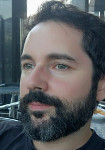
© 2021. All rights reserved.
Virtual Reality (VR) is a term that is increasingly known and present in our daily lives. Although this has been an area of research and development since at least the sixties, recent developments in consumer devices (e.g., Oculus Rift) shifted attention back to it. In this work we set out to explore a web framework for VR and how much effort a Web developer would need to create a 360º virtual tour. This work was done by Solange Santos in the context of a scientific initiation grant.
The Editorial for Volume 10, No. 1 issue of the Journal of Science and Technology of the Arts (CITARJ) was my last editorial as editor of this journal.
I have been working for CITARJ since 2011 and have been involved in various of the changes that have occurred throughout the years.
In this post, I publish a copy of my last editorial and I make a short overview of the history and evolution of CITARJ.
I organized and taught a course on Virtual Reality Environments for the Master of Design program of the Faculty of Creative Industries, University of Saint Joseph, Macau.
The course was organized around the A-Frame Virtual Reality framework.
Being web-based, A-Frame is an excellent framework to created Virtual Reality environments. The resulting environments run on any browser, and platform, making it easy to share and view the worlds. It supports desktop, mobile, and VR platforms (such as Oculus Rift, or HTC Vive) and controllers.
Este artigo foi originalmente publicado na Revista Programar #59: [https://www.revista-programar.info/edicoes/edicao-59/].
Este artigo foi originalmente publicado na Revista Programar #58: [https://www.revista-programar.info/anuncios/revista-programar-no-58-outubro-2017/].
subscribe via RSS